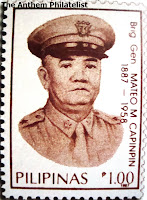Marcela Agoncillo on Stamps

Marcela Mariño de Agoncillo (June 24, 1860 – May 30, 1946), also simply known as Marcela Agoncillo, was a Filipina renowned in Philippine history as the principal seamstress of the first and official flag of the Philippines, gaining her the title of Mother of the Philippine Flag.
Agoncillo was a daughter of a rich family in her hometown of Taal, Batangas. Finishing her studies at Sta. Catalina College, she acquired her learning in music and feminine crafts. At the age of 30, Agoncillo married Filipino lawyer and jurist Don Felipe Agoncillo and bore him six children. Her marriage led to her important role in Philippine history. When her husband was exiled to Hong Kong during the outbreak of the Philippine Revolution, Agoncillo and the rest of the family joined him and temporarily resided there to avoid the anti-Filipino hostility of some foreign countries. While in Hong Kong, General Emilio Aguinaldo requested her to sew a flag that would represent their country. Agoncillo, her eldest daughter and a friend manually sewed the flag in accordance with General Aguinaldo's design which later became the official flag of the Philippines.
While the flag itself is the perpetual legacy of Agoncillo, she is also commemorated through museums and monuments like the marker in Hong Kong (where her family temporarily sojourned), at her ancestral home in Taal, Batangas which has been turned into a museum, in paintings by notable painters as well as through other visual arts.
Agoncillo was born on June 24, 1860 in Taal, Batangas, Philippines to Francisco Mariño and Eugenia Coronel. She grew up in their ancestral house in Batangas built in the 1770s by her grandfather, Andres Marino. As a daughter of a rich and religious family, Agoncillo was referred to in their town as Roselang Hubog which means "a virgin enthroned in the town church". Stories told in the area related that people kept waiting patiently by the church patio for her appearance in the morning to attend mass accompanied either by a maid or an elder relative.
She was sent to a convent after her education in Manila. The convent she was studying in was the Sta. Catalina College of the Dominican nuns, an exclusive school for girls, established in the Walled City of Intramuros where she finished her elementary and secondary education. In college, she learned Spanish, music, the feminine crafts and social graces. She spent her girlhood partly in their hometown and partly in the convent. Accordingly, Agoncillo was skilled in needlework.
Agoncillo and her daughters stayed in Hong Kong from 1895 to 1906. She took care of their house, which became an asylum. Their funds had run out because of the heavy expenses incurred by Don Felipe for his diplomatic activities in France and in the United States. She once had to sell the children's pinafores[16] and their jewels[10] to support her family and to pay for their voyage back to Manila. The other money was also used to help boost the revolutionary funds. Their support for the revolution made them an impoverished family; however, they gained it back when Don Felipe returned to his profession.
After the fall of the first Philippine Republic and the establishment of the American regime, Agoncillo and her family ended their exile and went back to Manila as soon as they were fetched by Don Felipe after his diplomatic activities abroad had ended. The Agoncillos settled in their family house in Malate. After the death of Don Felipe, Agoncillo's remaining family suffered from starvation due to their meager supply of food, water and other needs. The Japanese conquerors also contributed to their anguish during the period of the Japanese invasion. Taking this all in stride, Marcela remained pragmatic and a source of inspiration. After their house was incinerated during the Japanese occupation, all she said to her remaining daughters was "We will then have to go to Taal."
Though she endured the 1945 Battle of Manila, the health of Agoncillo, who was alternatively called "Doña Marcela" and "Lola Celay" during her old age, was steadily deteriorating. She continued to mourn her deceased husband to such an extent that her daughters found it necessary to hide all his remaining photographs. On May 30, 1946, she quietly died in Manila at the age of 86. Her mortal remains were brought from Taal to Manila and interred alongside her husband in the Catholic cemetery of La Loma according to the wishes of her last will.
The stamp above was issued in 1973.






